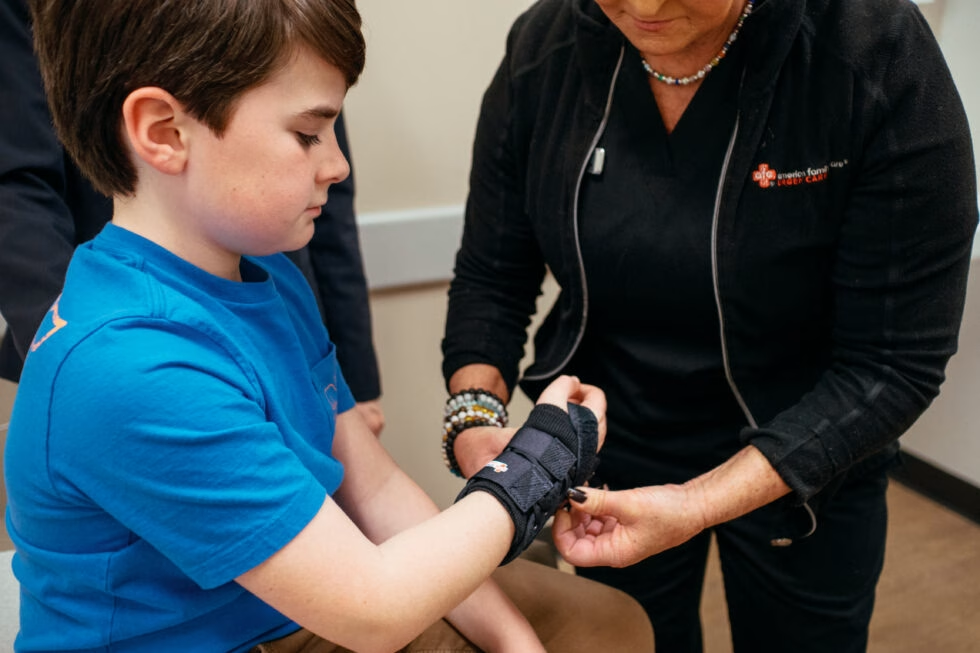
Trying to decide if your child needs an X-ray? Read our blog or stop by our urgent care to learn the science & safety features behind X-rays.
When you’ve been entrusted with the life of a little one, there’s a lot of things you have to consider. Like whether or not your kids will have more fun spending the evening at one of Athens’ many local parks or relaxing at the Athens Movie Palace. And if your child does sustain an injury, is it safe for them to get an X-ray?
At AFC, we’re more than just a walk-in urgent care, we’re family. You can count on us to help you make the right decisions when it comes to your child’s health. Digital X-rays are among one of the many services we provide, but how do they actually work? And are they safe for your little ones? Keep reading to learn more about the X-ray process and whether it can be beneficial to your child.
What is an X-ray?
Invented in 1895 by German physicist Wilhelm Conrad Röntgen, X-rays have now become a key tool in today’s health care. An X-ray is a medical imaging test that displays the inside of your body (typically your bones, joints and organs). An X-ray machine produces small amounts of radiation that pass through the body and are then captured on film or digitally. This procedure is painless and although it utilizes small dosages of radiation, it is regarded as safe and beneficial.
Are X-rays Dangerous?
The short answer is no, X-rays are considered safe. X-rays are high-energy electromagnetic radiation; however, as we’ve discussed, X-ray machines only need small amounts of radiation to accurately create images. In fact, a standard X-ray will expose you to radiation levels that match what you would naturally encounter in your daily life.
Here’s a comparison to help you understand:
- A chest X-ray = about 10 days of background radiation.
- A dental X-ray = about 1 day of background radiation.
While radiation exposure is usually very low, if you’re pregnant or recently had an X-ray speak with a trusted health care provider before getting another one.
Can My Child Get an X-ray?
Yes! When a provider or your primary care feels an X-ray is absolutely needed to diagnose and treat a medical condition, it is a perfectly safe choice. Medical professionals, especially our team at AFC Athens, abide by the ALARA principle, which stands for: as low as reasonably achievable. This ensures that anytime you get an X-ray, the lowest dosage of radiation needed to get a quality image is used. Whether you’re an adult or an adolescent, ALARA is always employed.
When following ALARA, the biggest factor to consider is actually the size of the patient, rather than the age. A patient’s size determines how much radiation is needed to produce an accurate and effective medical image.
Tips for parents and caregivers:
- Keep a record of your child’s X-rays to help inform your decision as to whether or not they should get a new one.
- Don’t hesitate to ask your provider questions.
- How will the X-ray improve your child’s health? Are there any other methods that are equally as useful but maybe less invasive?
- Ask questions pertaining to the facility.
- Does it use reduced radiation for pediatric imaging?
Digital X-rays at AFC Athens
At our clinic, your safety is our top priority. Not only do our experienced medical professionals follow the ALARA technique, but our state-of-the-art facility uses digital X-ray machines. Rather than purchasing and developing film, computers are able to capture X-ray images.
The benefits?
- Lower radiation levels.
- Clearer and sharper photos.
- Faster turnaround.
- Environmentally safer.
Here at AFC Athens, your health is our priority. Our skilled team and latest X-ray technology will ensure that you and your children receive accurate and compassionate care.
Common Pediatric Injuries
We see a lot of pediatric injuries, specifically ones that are sports related. Whether your kids are involved in swimming, volleyball or soccer – when injuries occur, sometimes it can be hard to tell if an X-ray is needed. Here are four signs that can help guide your decision.
- Severe pain: When the pain is extreme and doesn’t improve with rest and ice, an X-ray may be necessary to rule out a fracture.
- Visible deformity: If there’s a bone out of place or at an odd angle, an X-ray will be essential.
- Inability to bear weight: If your child is having problems putting weight on an injured foot, ankle or leg, X-rays can help determine if there’s a fracture or broken bone.
- Persistent swelling and bruising: After a few days, if swelling and bruising has not subsided, consider getting an X-ray to help identify the problem.
No Secrets Here, Just X-ray Clarity
To learn more about our digital X-rays at AFC, visit our website for more information, or stop by our office. We’re located at 2037 Congress Parkway S. Our team will be happy to answer any questions or concerns you may have about the X-ray process.
We get it – X-rays can be scary, but we’re dedicated to providing you and your whole family with safe care. We accept all walk-ins and offer extended hours. AFC is care you can trust.

